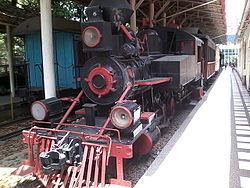 | ||
The Great Venezuela Railway (Gran Ferrocarril de Venezuela) was a 179-kilometre (111 mi) 3 ft 6 in (1,067 mm) railway from Caracas to Valencia. The railway was the longest in Venezuela; and became a notable cause of the Venezuela Crisis of 1902–1903. It fell into disrepair through the early 20th century and the last train ran in 1966.
Contents
Origin
Friedrich Krupp AG contracted with the Venezuelan government in 1888 to build the railway in exchange for £12,800 per kilometer to be repaid at 7 percent interest. Disconto-Gesellschaft financed the project; and terms were renegotiated at £11,000 per kilometer in 1891. The railway was completed in February 1894.
Description
The railway replaced a difficult carriage road through mountainous terrain. The Caracas station was adjacent to the 3-foot (0.91 m) gauge railway to the coast at La Guaira (closed 1951). The railway west entered the 285-metre (935 ft) Calvario tunnel for level grade to Antímano where a 2 percent climb began to a 1,227-metre (4,026 ft) summit in 267-metre (876 ft) Corozal tunnel 30 kilometres (19 mi) from Caracas. From Corozal tunnel the railway required 212 Krupp steel viaducts and 84 tunnels to cover 44 kilometres (27 mi) of gently descending grade across steep canyons to reach the fertile valley of Lake Valencia. The 106-metre (348 ft) viaduct over Agua Amarillo was the longest on the line and stood 47 metres (154 ft) above the water. By 1922 the railway had 18 locomotives, 30 passenger cars, 68 flatcars, and 20 stock cars. Although the 4-4-4T locos could reach 70 km/h (43 mph), trains took 7 hours for the 179km.
Financial difficulty
Contemporary accounts expressed great praise for the construction, which used Krupp steel railroad ties. Krupp computed Venezuela's debt (including damages arising from the revolution against Venezuelan president Raimundo Andueza Palacio) as £1,900,000. Suspension of debt payments by Cipriano Castro in 1901 was followed by German Empire gunboat diplomacy in Venezuela naval blockade of 1902.
Museum
The summit section of the railway forms part of the recreation Parque El Encanto and work began in 2015 on a 350 million bolivar plan to restore 7 km (4.3 mi) of track, with 7 tunnels and 5 bridges, providing for a 25 minute journey from Los Lagos to El Encanto.
